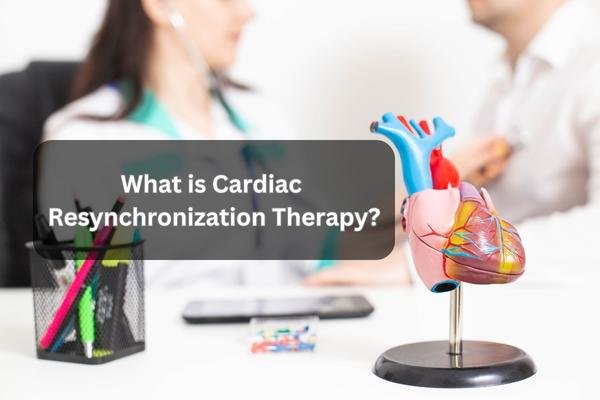
Cardiac resynchronization therapy (CRT) is a sophisticated treatment that involves placing a small device within the chest to assist the heart in contracting in a more synchronized manner. It is an innovative treatment option for those suffering from heart failure and other related heart conditions. In this section, we will explore the concept of CRT and gain a comprehensive understanding of what it entails.
What is Cardiac Resynchronization Therapy?
Cardiac resynchronization therapy (CRT) is a treatment that uses a pacemaker-like device to improve the coordination of the heart’s contractions in patients with heart failure. This therapy is also known as biventricular pacing, as it involves pacing both the left and right ventricles of the heart.
The purpose of CRT is to improve the efficiency of the heart, which can be compromised in patients with heart failure. It works by sending electrical signals to the heart to synchronize its contractions, allowing the heart to pump blood more effectively.
CRT is often recommended for patients with moderate-to-severe heart failure who have not responded to other treatments, such as medication. It can also be effective in patients with certain types of heart diseases, such as dilated cardiomyopathy and left bundle branch block.
How it Works
The CRT device is implanted under the skin of the chest and connected to the heart with thin wires called leads. The device sends electrical impulses through the leads to pace both ventricles of the heart simultaneously.
The timing of the electrical impulses is carefully programmed so that both ventricles contract together, improving the efficiency of the heart’s pumping action.
In addition to pacing the ventricles, some CRT devices also include an implantable cardioverter defibrillator (ICD) function. This can help to prevent dangerous heart rhythms by delivering a shock to the heart if needed.
Conditions Treated
CRT is primarily used to treat patients with heart failure, particularly those with moderate-to-severe symptoms that have not responded to other treatments. It can also be effective in patients with certain types of heart diseases, such as dilated cardiomyopathy and left bundle branch block.
Some of the symptoms that CRT can help to alleviate include:
- Shortness of breath
- Fatigue
- Swelling in the legs and ankles
- Difficulty exercising
Research has shown that CRT can significantly improve these symptoms, as well as reduce hospitalizations and mortality rates in patients with heart failure.
It is essential to understand that CRT is not suitable for all patients with heart failure and that a thorough evaluation is necessary to determine if a patient is a suitable candidate for this treatment.
In the following sections, we will delve further into who can benefit from CRT, how the need for CRT is evaluated, and what patients can expect during and after the procedure.
Who Can Benefit from Cardiac Resynchronization Therapy?
Cardiac resynchronization therapy (CRT) is a highly effective treatment for individuals with heart failure. Research has shown that CRT can improve symptoms, reduce hospitalizations and mortality rates, and increase quality of life for eligible patients.
CRT benefits patients who have:
- Chronic heart failure
- Reduced ejection fraction
- Left bundle branch block (LBBB) or right ventricular pacing with QRS duration of 150 ms or more
These symptoms and conditions indicate that the heart muscle is not contracting effectively, causing the heart to pump less blood, leading to fatigue, shortness of breath, and other symptoms often experienced by heart failure patients.
| Benefit | Description |
| Improved symptoms | CRT can reduce symptoms such as fatigue, shortness of breath, and swelling in the legs, leading to an improved quality of life. |
| Reduced hospitalizations and mortality rates | CRT can lower the risk of hospitalizations and mortality rates for patients with heart failure. |
| Increased exercise capacity | CRT can improve the heart’s ability to function during physical activity, leading to an increased exercise capacity. |
Not all heart failure patients are eligible for CRT, and it is essential to consult with a healthcare provider to evaluate if CRT is the right treatment option. Factors that may impact eligibility include the patient’s age, overall health, and individual medical history.
Evaluating the Need for Cardiac Resynchronization Therapy
Cardiac resynchronization therapy (CRT) is a specialized treatment that can help improve heart function and relieve symptoms in certain patients. However, not all individuals with heart conditions are eligible for this procedure. To determine if a patient would benefit from CRT, doctors typically conduct a series of tests and evaluations to assess the level of heart dysfunction and confirm the diagnosis.
Diagnostic Tests and Criteria
The diagnostic tests used to evaluate the need for CRT include electrocardiogram (ECG), echocardiogram, and stress test. These tests can provide critical information on the heart’s rhythm, size, and function. In addition, patients are evaluated based on specific criteria such as heart failure symptoms, left ventricular ejection fraction (LVEF), and QRS duration.
Doctors typically use a combined approach to evaluate patients for CRT, looking not only at the test results but also taking into account the patient’s medical history, current medications, and other health factors.
In summary, cardiac resynchronization therapy is a specialized treatment that can significantly improve the quality of life of certain patients with heart conditions. Proper evaluation and diagnosis are key to determining the need for this procedure and ensuring its successful outcomes.
Recovery and Follow-Up Care
After the procedure, patients should expect to stay in the hospital for a few days to monitor their recovery. It is recommended to avoid strenuous activity for at least a week to allow the body to heal and adjust to the new device. During this time, patients may experience temporary pain, swelling, or bruising at the implant site, but these symptoms should subside in a few days.
For follow-up care, patients should schedule regular appointments with their healthcare provider to monitor the effectiveness of the treatment. This may include routine check-ups, device assessments, and device programming adjustments to optimize the therapy. Regular follow-up care is essential to ensure the device is functioning correctly and to detect any potential complications early.
Benefits of Cardiac Resynchronization Therapy
Cardiac Resynchronization Therapy (CRT) has been shown to be effective in managing symptoms and improving the quality of life for patients with heart failure and electrical conduction problems. Here are some of the advantages and limitations associated with this treatment:
Improved Symptoms:
Cardiac Resynchronization Therapy has been shown to improve a variety of symptoms associated with heart failure, such as shortness of breath and fatigue. In addition, it can increase exercise tolerance and overall quality of life.
Reduced Hospitalizations:
Studies have found that CRT can reduce the number of hospitalizations and emergency room visits in heart failure patients, improving their overall health outcomes and reducing healthcare costs.
Long-Term Benefits:
CRT has been shown to provide long-term benefits for patients with heart failure, with some studies reporting improved survival rates up to 5 years after treatment.
In conclusion, Cardiac Resynchronization Therapy (CRT) has emerged as a crucial treatment option for enhancing heart function and alleviating symptoms in eligible patients with heart failure. With its ability to improve quality of life, reduce hospitalizations, and potentially extend survival rates, CRT stands as a promising solution for those facing heart-related challenges. To explore this advanced therapy further, individuals can seek guidance from specialized healthcare providers, such as a reputable CRT hospital in Pune, ensuring comprehensive evaluation and personalized care.


